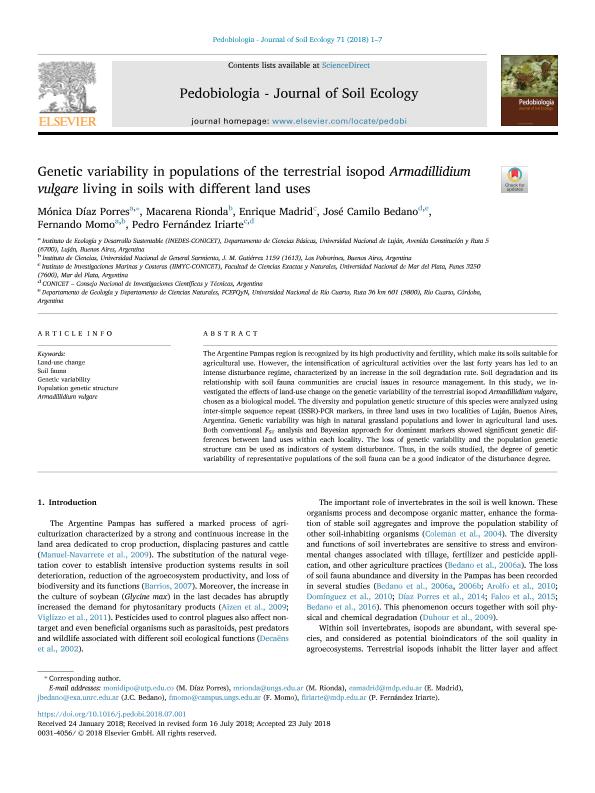Mostrar el registro sencillo del ítem
dc.contributor.author
Diaz Porres, Monica

dc.contributor.author
Rionda, Macarena

dc.contributor.author
Madrid, Enrique
dc.contributor.author
Bedano, José Camilo

dc.contributor.author
Momo, Fernando Roberto

dc.contributor.author
Fernandez Iriarte, Pedro Jose

dc.date.available
2019-11-07T19:25:49Z
dc.date.issued
2018-11
dc.identifier.citation
Diaz Porres, Monica; Rionda, Macarena; Madrid, Enrique; Bedano, José Camilo; Momo, Fernando Roberto; et al.; Genetic variability in populations of the terrestrial isopod Armadillidium vulgare living in soils with different land uses; Elsevier Gmbh; Pedobiologia; 71; 11-2018; 1-7
dc.identifier.issn
0031-4056
dc.identifier.uri
http://hdl.handle.net/11336/88229
dc.description.abstract
The Argentine Pampas region is recognized by its high productivity and fertility, which make its soils suitable for agricultural use. However, the intensification of agricultural activities over the last forty years has led to an intense disturbance regime, characterized by an increase in the soil degradation rate. Soil degradation and its relationship with soil fauna communities are crucial issues in resource management. In this study, we investigated the effects of land-use change on the genetic variability of the terrestrial isopod Armadillidium vulgare, chosen as a biological model. The diversity and population genetic structure of this species were analyzed using inter-simple sequence repeat (ISSR)-PCR markers, in three land uses in two localities of Luján, Buenos Aires, Argentina. Genetic variability was high in natural grassland populations and lower in agricultural land uses. Both conventional FST analysis and Bayesian approach for dominant markers showed significant genetic differences between land uses within each locality. The loss of genetic variability and the population genetic structure can be used as indicators of system disturbance. Thus, in the soils studied, the degree of genetic variability of representative populations of the soil fauna can be a good indicator of the disturbance degree.
dc.format
application/pdf
dc.language.iso
eng
dc.publisher
Elsevier Gmbh

dc.rights
info:eu-repo/semantics/openAccess
dc.rights.uri
https://creativecommons.org/licenses/by-nc-sa/2.5/ar/
dc.subject
ARMADILLIDIUM VULGARE
dc.subject
GENETIC VARIABILITY
dc.subject
LAND-USE CHANGE
dc.subject
POPULATION GENETIC STRUCTURE
dc.subject
SOIL FAUNA
dc.subject.classification
Genética y Herencia

dc.subject.classification
Ciencias Biológicas

dc.subject.classification
CIENCIAS NATURALES Y EXACTAS

dc.title
Genetic variability in populations of the terrestrial isopod Armadillidium vulgare living in soils with different land uses
dc.type
info:eu-repo/semantics/article
dc.type
info:ar-repo/semantics/artículo
dc.type
info:eu-repo/semantics/publishedVersion
dc.date.updated
2019-10-24T19:08:50Z
dc.identifier.eissn
1873-1511
dc.journal.volume
71
dc.journal.pagination
1-7
dc.journal.pais
Alemania

dc.description.fil
Fil: Diaz Porres, Monica. Universidad Nacional de Luján; Argentina
dc.description.fil
Fil: Rionda, Macarena. Universidad Nacional de General Sarmiento; Argentina
dc.description.fil
Fil: Madrid, Enrique. Consejo Nacional de Investigaciones Científicas y Técnicas. Centro Científico Tecnológico Conicet - Mar del Plata. Instituto de Investigaciones Marinas y Costeras. Universidad Nacional de Mar del Plata. Facultad de Ciencias Exactas y Naturales. Instituto de Investigaciones Marinas y Costeras; Argentina
dc.description.fil
Fil: Bedano, José Camilo. Consejo Nacional de Investigaciones Científicas y Técnicas; Argentina
dc.description.fil
Fil: Momo, Fernando Roberto. Universidad Nacional de General Sarmiento; Argentina
dc.description.fil
Fil: Fernandez Iriarte, Pedro Jose. Consejo Nacional de Investigaciones Científicas y Técnicas. Centro Científico Tecnológico Conicet - Mar del Plata. Instituto de Investigaciones Marinas y Costeras. Universidad Nacional de Mar del Plata. Facultad de Ciencias Exactas y Naturales. Instituto de Investigaciones Marinas y Costeras; Argentina
dc.journal.title
Pedobiologia

dc.relation.alternativeid
info:eu-repo/semantics/altIdentifier/url/https://www.sciencedirect.com/science/article/abs/pii/S0031405618300131
dc.relation.alternativeid
info:eu-repo/semantics/altIdentifier/url/https://doi.org/10.1016/j.pedobi.2018.07.001
Archivos asociados
